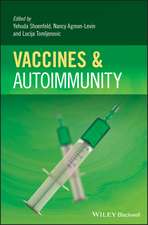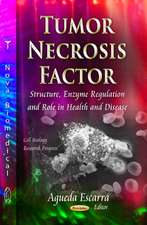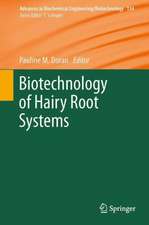Autoimmunity: Experimental Aspects: Nato ASI Subseries H:, cartea 80
Editat de Moncef Zoualien Limba Engleză Paperback – 13 dec 2011
Din seria Nato ASI Subseries H:
- 18%
 Preț: 953.82 lei
Preț: 953.82 lei -
 Preț: 393.13 lei
Preț: 393.13 lei - 15%
 Preț: 643.34 lei
Preț: 643.34 lei - 15%
 Preț: 643.34 lei
Preț: 643.34 lei - 15%
 Preț: 641.03 lei
Preț: 641.03 lei - 15%
 Preț: 642.83 lei
Preț: 642.83 lei - 15%
 Preț: 642.51 lei
Preț: 642.51 lei - 5%
 Preț: 712.81 lei
Preț: 712.81 lei -
 Preț: 392.97 lei
Preț: 392.97 lei - 15%
 Preț: 651.02 lei
Preț: 651.02 lei - 15%
 Preț: 640.24 lei
Preț: 640.24 lei - 18%
 Preț: 948.61 lei
Preț: 948.61 lei - 15%
 Preț: 655.92 lei
Preț: 655.92 lei - 15%
 Preț: 655.92 lei
Preț: 655.92 lei - 15%
 Preț: 653.14 lei
Preț: 653.14 lei - 15%
 Preț: 650.19 lei
Preț: 650.19 lei - 15%
 Preț: 655.13 lei
Preț: 655.13 lei - 15%
 Preț: 652.17 lei
Preț: 652.17 lei - 15%
 Preț: 675.58 lei
Preț: 675.58 lei - 18%
 Preț: 958.07 lei
Preț: 958.07 lei - 18%
 Preț: 961.41 lei
Preț: 961.41 lei - 18%
 Preț: 970.56 lei
Preț: 970.56 lei - 5%
 Preț: 1100.30 lei
Preț: 1100.30 lei - 5%
 Preț: 376.43 lei
Preț: 376.43 lei - 15%
 Preț: 650.86 lei
Preț: 650.86 lei - 15%
 Preț: 644.63 lei
Preț: 644.63 lei - 15%
 Preț: 655.60 lei
Preț: 655.60 lei - 18%
 Preț: 963.47 lei
Preț: 963.47 lei - 15%
 Preț: 648.42 lei
Preț: 648.42 lei - 5%
 Preț: 731.43 lei
Preț: 731.43 lei - 15%
 Preț: 653.14 lei
Preț: 653.14 lei - 18%
 Preț: 960.13 lei
Preț: 960.13 lei - 18%
 Preț: 968.34 lei
Preț: 968.34 lei - 18%
 Preț: 953.97 lei
Preț: 953.97 lei - 15%
 Preț: 654.95 lei
Preț: 654.95 lei - 15%
 Preț: 652.49 lei
Preț: 652.49 lei - 15%
 Preț: 650.86 lei
Preț: 650.86 lei - 5%
 Preț: 367.64 lei
Preț: 367.64 lei - 5%
 Preț: 1104.68 lei
Preț: 1104.68 lei - 18%
 Preț: 953.20 lei
Preț: 953.20 lei - 15%
 Preț: 651.99 lei
Preț: 651.99 lei - 15%
 Preț: 647.27 lei
Preț: 647.27 lei - 15%
 Preț: 653.00 lei
Preț: 653.00 lei - 15%
 Preț: 656.25 lei
Preț: 656.25 lei - 18%
 Preț: 962.35 lei
Preț: 962.35 lei - 15%
 Preț: 644.82 lei
Preț: 644.82 lei - 15%
 Preț: 666.55 lei
Preț: 666.55 lei - 15%
 Preț: 642.68 lei
Preț: 642.68 lei - 15%
 Preț: 645.96 lei
Preț: 645.96 lei - 15%
 Preț: 651.84 lei
Preț: 651.84 lei
Preț: 717.37 lei
Preț vechi: 755.13 lei
-5% Nou
Puncte Express: 1076
Preț estimativ în valută:
137.31€ • 149.20$ • 115.42£
137.31€ • 149.20$ • 115.42£
Carte tipărită la comandă
Livrare economică 21 aprilie-05 mai
Preluare comenzi: 021 569.72.76
Specificații
ISBN-13: 9783642787812
ISBN-10: 3642787819
Pagini: 328
Ilustrații: XVI, 302 p.
Dimensiuni: 155 x 235 x 17 mm
Greutate: 0.46 kg
Ediția:Softcover reprint of the original 1st ed. 1994
Editura: Springer Berlin, Heidelberg
Colecția Springer
Seria Nato ASI Subseries H:
Locul publicării:Berlin, Heidelberg, Germany
ISBN-10: 3642787819
Pagini: 328
Ilustrații: XVI, 302 p.
Dimensiuni: 155 x 235 x 17 mm
Greutate: 0.46 kg
Ediția:Softcover reprint of the original 1st ed. 1994
Editura: Springer Berlin, Heidelberg
Colecția Springer
Seria Nato ASI Subseries H:
Locul publicării:Berlin, Heidelberg, Germany
Public țintă
ResearchCuprins
1. Thymic Selection and Peripheral T cell Tolerance.- Tolerance induction in mature peripheral T cells.- Transgenic mice carrying the rearranged T cell receptor of a diabetogenic T cell clone.- The maintenance and reestablishment of self tolerance: T cell receptor (TCR) peptide-specific regulatory T cells.- Prevention of gastric autoimmunity by transgenic expression of a proton pump subunit in the thymus.- 2. B-cell repertoire selection.- The anti-self B-cell repertoire.- In vivo suppression of IgG2ab production accomplished by CD4+8? Th1 cell clones specific for a ?2ab allopeptide determinant.- 3. Targets of the autoimmune response.- Expression cloning using antibodies from a patient with rheumatoid arthritis of an autoantigen homologous to the Drosophila splicing regulator, suppressor-of-white-apricot.- Use of synthetic peptides for the analysis of B-cell epitopes in autoantigens.- Molecular mimicry as a mechanism of induction of autoantibodies.- The expression of heat shock proteins in systemic lupus erythematosus.- 4. Trigger Mechanisms of autoantibody production.- The Heavy chain variable region genes of human lupus autoantibodies.- Molecular analysis of anti-dsDNA autoantibodies from patients with systemic lupus erythematosus.- Differential usage of an autoantibody-associated VH gene by human B-cell tumors.- Idiotypes of DNA-binding autoantibodies: mapping by epitope scanning and molecular modelling.- 5. T Cell Receptor Genes.- T cell receptor variable gene repertoire in rheumatoid synovial T cells responding to BCG.- An analysis of T cell receptor diversity in the NOD mouse: What can it tell us about the autoimmune process?.- Possible linkage of Myasthenia Gravis susceptibility in R111 S/J mice to a genomic deletion of T cell receptor V? genes.- Genetic andenvironmental factors in systemic lupus erythematosus.- 6. Animal Models and Immunointervention.- Role of immunocompetent cells in skin sclerosis and autoimmunity in tight skin mice.- MRL/lpr mice as a model of autoimmune diseases: multiple strategies for immune intervention.- Major histocompatibility binding peptides: an experimental approach towards specific immunotherapy of autoimmune diseases.- Type-I (insulin-dependent) and type-II (non-insulin-dependent) diabetes mellitus in BC1 [(NOD × Mus spretus) F1 × NOD] mice.










